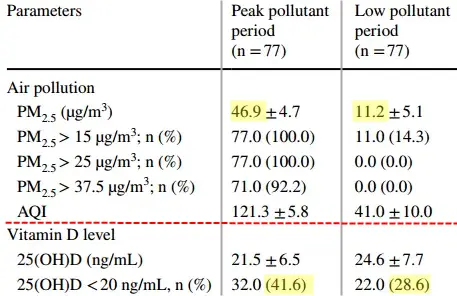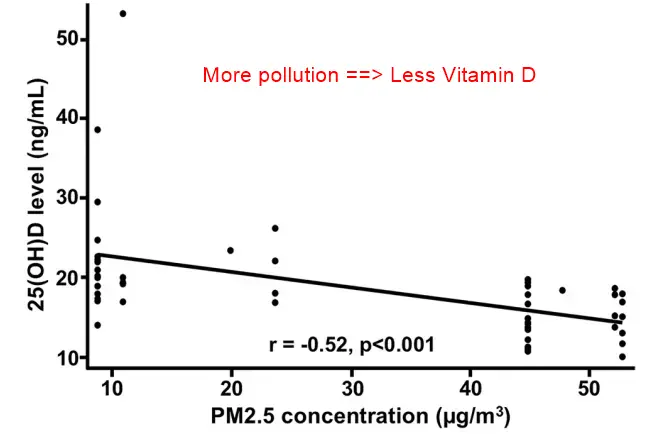1.4 X more likely to be Vitamin D deficient if high PM2.5 (why: indoors, less UV, inflammation)
Exposure to seasonal PM2.5 derived from biomass burning increased the risk of vitamin D deficiency in healthy perimenopausal women
Int Arch Occup Environ Health . 2025 May 21. doi: 10.1007/s00420-025-02149-4
Mattabhorn Phimphilai 1, Sridanai Watthanawongkeeree 2, Worapaka Manosroi 2


Objective: Southeast Asia faces problems with seasonal air pollution from biomass burning. Data regarding vitamin D deficiency and seasonal air pollution is limited. Therefore, this study aimed to determine the effects of seasonal air pollutants on vitamin D deficiency and the predictors of vitamin D deficiency during haze periods.
Methods: This prospective cohort study included 77 peri-menopausal women. All participants were enrolled and followed at the peak and low pollutant periods, respectively. Serum 25-hydroxyvitamin D (25(OH)D) was measured at both points. Data regarding 24 h particulate matter with a diameter less than 2.5 µm (PM2.5) was obtained from the database of the Pollution Control Department of Thailand.
Results: The ambient 24 h PM2.5 was higher (46.9 ± 4.7 µg/m3 vs. 11.2 ± 5.1 µg/m3, P < 0.001) at the peak pollutant period. In contrast, serum 25(OH)D level was 18.8% lower, and the incidence of vitamin D deficiency was 45.4% higher at the peak pollutant period compared to those at the low pollutant period. Seasonal air pollutants were associated with an increased risk of vitamin D deficiency by 3.5 folds [OR 3.5 (95% CI 1.1-14.6)]. The ambient 24 h PM2.5 during the peak pollutant periods was an independent predictor of vitamin D deficiency. Its threshold of 20 µg/m3 demonstrated sensitivity, specificity, and accuracy of 75.0%, 85.7%, and 78.0%, respectively, to predict the occurrence of vitamin D deficiency.
Conclusion: Seasonal air pollutants increase the risk of vitamin D deficiency. The ambient 24 h PM2.5 at 20 µg/m3 demonstrated high diagnostic performance for vitamin D deficiency.
Download the PDF from Vitamin D Life
